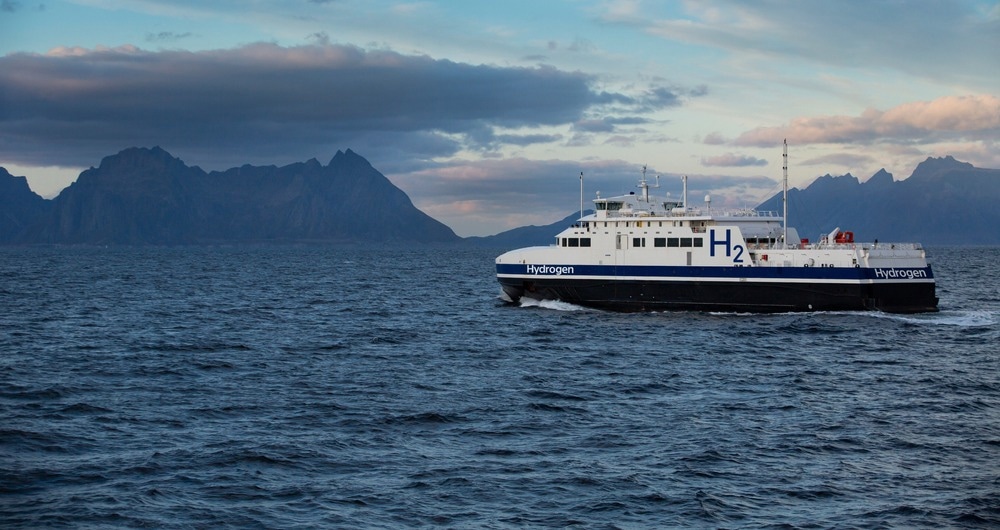Shipping accounts for 3% of the world’s total emissions. While this percentage seems small, it represents emissions of more than 833 million tons of CO2 annually, and the figure is growing. The sector’s carbon emissions grew by 4.9% in 2021, undermining the International Maritime Organization’s (IMO) promise to cut global shipping emissions by at least 40% by 2030, and by 70% by 2050 compared to 2008, in an attempt to align with global climate change goals. Shipping companies will need to make drastic steps to cut emissions if these goals are to be met. The Scottish shipping industry is making significant steps towards decarbonizing its fleets.

Image Credit: Scharfsinn/Shutterstock.com
Orkney: A Leader in Pioneering a Hydrogen Economy
Since 2016, Orkney, an archipelago off the northeastern coast of Scotland, has been planning its hydrogen-based economy. By 2017, five vans that run on hydrogen had arrived. However, the islands did not at that time have the means to produce hydrogen to fill them. Now, the archipelago’s hydrogen stations are just as part of daily life as petrol stations are on the mainland.
In 2021, the islands revealed the design of the world’s first hydrogen-powered car and passenger ferry, which potentially represents the first step towards establishing the world’s first entire fleet of carbon-free vessels, whether it be in Orkney or elsewhere in the world, inspired by the Scottish passenger ferry’s success.
The idea of the ferry came into existence as a product of HySeas III, the final part of a three-part research program established to develop the world’s first sea-going vehicle and passenger ferry. The vehicle will run between Kirkwall and Shapinsay in Orkney, carrying passengers and cars across the 25-minute route without emitting greenhouse gases.
Orkney was selected to be the home of the ferry for a particular reason: the island community is known globally as a leader in pioneering a hydrogen economy. Success in Orkney will be necessary for inspiring similar global projects, establishing renewable energy economies in other communities, and facilitating the move from fossil fuels to green alternatives.
The islands of the archipelago have more wind and tidal energy than their population of little more than 22,000 can use.
The national grid, however, cannot always take on the surplus it produces. Instead of shutting down its wind turbines, the community has decided to use its surplus energy supply to power electrolysis, splitting water molecules into their components of oxygen and hydrogen. As a result, the community produces vast amounts of the clean energy source, hydrogen.
When hydrogen is burned to generate power, it does not produce harmful greenhouse gases, such as burning fossil fuels such as petrol or diesel. The only byproduct of the reaction is pure water. Another benefit of producing hydrogen from a surplus of clean energy, such as wind power, is that hydrogen can easily be stored and transported to other areas of the world where clean energy is in demand.
Is Hydrogen Completely Clean?
While hydrogen does not produce emissions when burned, producing hydrogen requires an energy source, which is not always derived from a renewable source.
In Orkney, renewable wind energy powers the electrolysis reaction to separate hydrogen from water. However, this is not the case in other circumstances. For example, a cheap way to produce hydrogen involves using methane and carbon capture and storage (CCS). While there is an argument that this is useful when producing hydrogen on a large scale, it is not as clean. To establish a truly green economy, hydrogen should be produced with a renewable energy source.
A Big Step Towards Decarbonizing Scotland and the World
As well as providing a template for decarbonizing shipping, Orkney has demonstrated how it may be possible to decarbonize larger communities. For example, even after exporting its surplus energy to the UK national grid, Orkney’s renewable energy sources of wind, wave, and tidal power produce around 130% of the electricity it needs.
All this energy comes from clean, renewable sources. The community has shown that this energy can be converted into hydrogen energy, which can be easily stored and transported, making clean hydrogen energy more accessible to nearby communities in Scotland. This strategy could easily be adopted at other locations in the UK and worldwide. It demonstrates that a sharing economy could prove a vital solution to tackling climate change by helping heavy consumers of energy switch to renewables.
The success of Orkney’s hydrogen economy may provide a valuable blueprint to other communities, and in the coming years, we may see more hydrogen economies established worldwide.
References and Further Reading
2021. Design of Orkney hydrogen-powered ferry revealed [online]. The Orcadian. Available from: https://www.orcadian.co.uk/design-of-orkney-hydrogen-powered-ferry-revealed/ (last accessed December 2022)
Calum Watson. Will Scotland build a hydrogen-powered ship? [online]. BBC. Available from: https://www.bbc.co.uk/news/uk-scotland-61988917 (last accessed December 2022)
Diego Arguedas Ortiz. 2019. How hydrogen is transforming these tiny Scottish islands [online]. BBC. Available from: https://www.bbc.com/future/article/20190327-the-tiny-islands-leading-the-way-in-hydrogen-power (last accessed December 2022)
Michelle Wiese Bockmann. 2022. Shipping emissions rise 4.9% in 2021 [online]. Lloyd’s List. Available from: https://lloydslist.maritimeintelligence.informa.com/LL1139627/Shipping-emissions-rise-49-in-2021 (last accessed December 2022)
Disclaimer: The views expressed here are those of the author expressed in their private capacity and do not necessarily represent the views of AZoM.com Limited T/A AZoNetwork the owner and operator of this website. This disclaimer forms part of the Terms and conditions of use of this website.